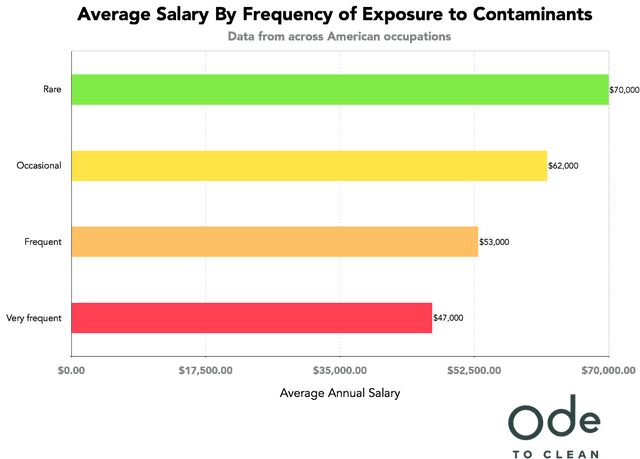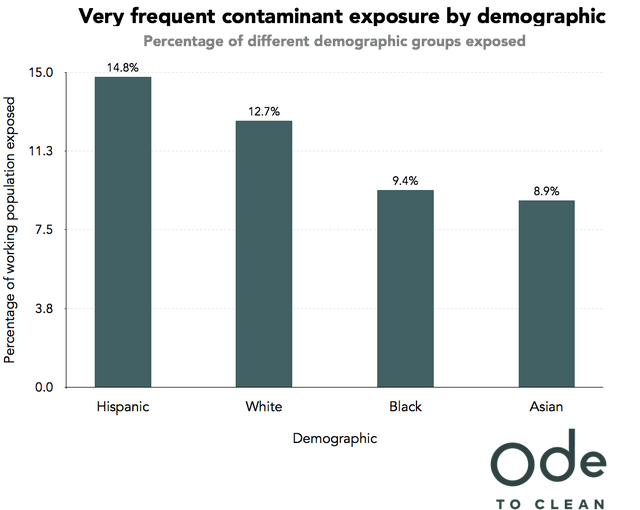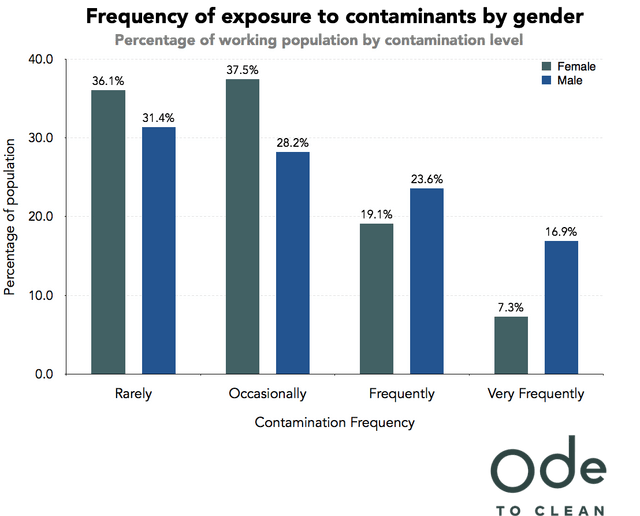
This post is adapted from the blog of Ode to Clean, a Priceonomics Data Studio customer. Does your company have interesting data? Become a Priceonomics customer.
***
Which occupations expose workers to the most contaminants? How often are American workers exposed to these contaminants, who are these workers, and how much are they paid? We decided to attempt to answer these questions by exploring the data.
We analyzed this data along with Priceonomics customer, Ode, a company that creates environmentally-conscious cleaning products. Using resources from the Occupational Information Network and the Bureau of Labor Statistics, we were able to investigate the relationship between different job categories, demographics, and levels of contamination.
We found that automotive service technicians have the most contaminant-heavy job in America: they are exposed to pollutants, dust, gases or odors on a daily basis. HVAC and refrigeration technicians, truck drivers and tractor operators experience similar levels of contamination. Workers who are exposed to contaminants more than once a week make nearly one-third less than those who are exposed less than once a month.
Of the occupations with the highest level of contaminant exposure—more than once a week—farmworkers make the least, and dental hygienists make the most. Men are disproportionately exposed to high levels of contamination, as are people identifying as Hispanic. Salaries for jobs with very frequent contaminant exposure run the gamut, with the most highly paid workers making more than three times as much as the lowest-paid.
***
The data provided by the Occupational Information Network (O*Net) uses a scale from 0 to 100: employees in occupations with level 0 are never exposed to contaminants, while those in occupations with level 100 are exposed every day. The following chart shows the twenty occupations that expose employees to the highest levels of contamination:

Many of the most contaminant-heavy occupations involve cars or trucks, while others involve heavy machinery. It’s particularly interesting that dental hygienists (the tenth-most-exposed to contamination) also happen to be the highest paid of all occupations very frequently exposed to contaminants, as we’ll see further down.
How much are these workers paid? And are workers paid differently across different levels of contaminant exposure? The chart below shows average wages across occupations for four different frequencies of contaminant exposure:

Original source: Ode
Average salaries decrease substantially as contaminant exposure gets more frequent. The average wage for occupations that are only rarely exposed to contaminants exceeds the average wage for those that are very frequently exposed by about 25%. Each progressively higher contamination bucket works out to a drop of about $10,000 in annual wages.
Let’s look up close at the data– in particular, let’s look at the “Very Frequent” contamination bucket, in which workers are exposed to contaminants at least once a week. The chart below lists the ten best-paying occupations at the highest contamination level:

Dental hygienists, who are among the employees most often exposed to contaminants, are also among the most highly paid. Though automotive service technicians and dental hygienists are both exposed to contaminants more often than once a week, hygienists make almost twice as much annually. Now, let’s take a look at the lowest-paying jobs in the category of very frequent contaminant exposure:

The lowest-paid group of workers in the entire “Very Frequent” contaminant exposure category are Farmworkers and Laborers. These workers are very poorly paid indeed: Maintenance and Repair Workers, the tenth-lowest-paid workers in our dataset, make over 50% more than farmworkers!
We can dig into these result deeper by exploring the demographics of different occupations and levels of contamination. The chart below breaks down the occupations with very frequent contaminant exposure by demographic. It’s important to note that the categories are not totally exclusive: the “Hispanic” category can include individuals who identify as either white or black.

Original source: Ode
About one in every seven Hispanic workers is exposed to contaminants more than once a week; that’s nearly twice the proportion of workers who identify as Asian. Though this could be a function of the overlapping racial categories used in this dataset, it could also be evidence of larger societal dynamics at play. As we saw above, farmworkers hold the lowest-paid high-contamination job. Although only 18% of Americans are Hispanic, 80% of all farmworkers are.
Now that we’ve seen how contaminant exposure breaks down across racial categories, let’s take a look at the gender distribution. The chart below breaks down contaminant exposure by gender. Are either men or women more likely to be exposed to high levels of contaminants?

Original source: Ode
About one in every six men—and one in fourteen women—is employed in an occupation where they are exposed to contaminants more often than once a week. More than half of women are employed in occupations where they are rarely or occasionally exposed to contaminants, though roughly similar proportions of men and women occupy these professions.
According to public data, occupations with exposure to contaminants such as pollutants, gases, dust or odors achieve progressively lower average wages with more frequent exposure. Both the lowest- and highest-paid high-contamination jobs tend to involve manual labor or heavy machinery. We discovered that Hispanic workers are the group most frequently exposed to contaminants, and that men disproportionately occupy high-contaminant jobs. In general, it looks as though certain groups are frequently exposed to contaminants– and paid less for their trouble.
***
Note: If you’re a company that wants to work with Priceonomics to turn your data into great stories, learn more about the Priceonomics Data Studio.



